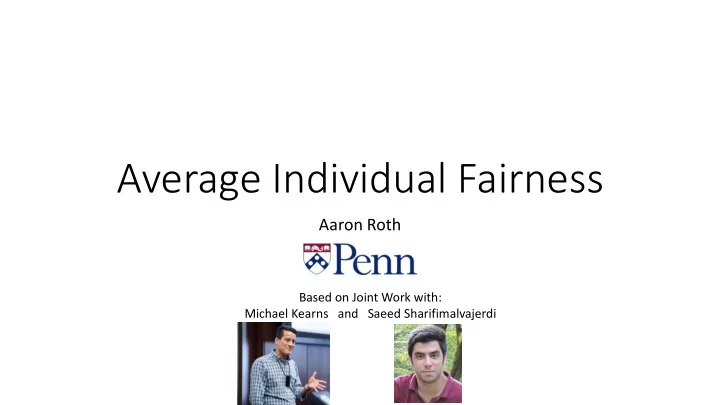

Average Individual Fairness Aaron Roth Based on Joint Work with: Michael Kearns and Saeed Sharifimalvajerdi
SAT Score GPA Population 1 Population 2
SAT Score GPA Population 1 Population 2
SAT Score GPA Population 1 Population 2
Why was the classifier “unfair”? Question : Who was harmed? Possible Answer : The qualified applicants mistakenly rejected. False Negative Rate : The rate at which harm is done. Fairness : Equal false negative rates across groups? [Chouldechova], [Hardt, Price, Srebro], [Kleinberg, Mullainathan, Raghavan] Statistical Fairness Definitions: 1. Partition the world into groups (often according to a “protected attribute”) 2. Pick your favorite statistic of a classifier. 3. Ask that the statistic be (approximately) equalized across groups.
But… • A classifier equalizes false negative rates. What does it promise you? • The rate in false negative rate assumes you are a uniformly random member of your population. • If you have reason to believe otherwise, it promises you nothing…
For example • Protected subgroups: “Men”, “Women”, “Blue”, “Green”. Labels are independent of attributes. • The following allocation equalizes false negative rates across all four groups. Blue Green Male Female
Sometimes individuals are subject to more than one classification task…
The Idea • Postulate a distribution over problems and individuals . • Ask for a mapping between problems and classifiers that equalizes false negative rates across every pair of individuals. • Redefine rate : Averaged over the problem distribution . An individual definition of fairness.
A Formalization • An unknown distribution 𝑄 over individuals 𝑦 𝑗 ∈ 𝑌 • An unknown distribution 𝑅 over problems 𝑔 𝑘 : 𝑌 → {0,1} , 𝑔 𝑘 ∈ 𝐺 • A hypothesis class 𝐼 ⊆ 0,1 𝑌 (Note 𝑔 𝑘 ’s not necessarily in 𝐼 ) • Task: Find a mapping from problems to hypotheses 𝜔 ∈ Δ𝐼 𝐺 • A new “problem” will be represented as a new labelling of the training set. • Finding the hypothesis corresponding to a new problem shouldn’t require resolving old problems. (Allows online decision making)
What to Hope For (Computationally) • Machine learning learning is already computationally hard [KSS92,KS08,FGKP09,FGPW14,…] even for simple classes like halfspaces. • So we shouldn’t hope for an algorithm with worst - case guarantees… • But we might hope for an efficient reduction to unconstrained (weighted) learning problems. • “Oracle Efficient Algorithms” • This design methodology often results in practical algorithms.
Computing the Optimal Empirical Solution. 1 = 1/𝑜 for each 𝑗 ∈ {1, … , 𝑜} Initialize 𝜇 𝑗 log 𝑜 For 𝑢 = 1 to 𝑈 = 𝑃 𝜗 2 • Learner Best Responds : 𝑜 𝑢 = 𝐵(𝑇 𝑢 = 𝑢 + 1 𝑢 ) for 𝑇 • For each problem 𝑘 , solve the learning problem ℎ 𝑘 𝜇 𝑗 𝑜 , 𝑦 𝑗 , 𝑔 𝑘 𝑦 𝑗 𝑘 𝑘 𝑗=1 • Set 𝛿 𝑢 = 𝟐[σ 𝑗 𝑜 𝜇 𝑗 𝑢 ≥ 0] • Auditor Updates Weights : 𝑢 by (𝑓𝑠𝑠 𝑦 𝑗 , ℎ 𝑢 , 𝑢+1 . • Multiply 𝜇 𝑗 𝑅 − 𝛿) for each expert 𝑗 and renormalize to get updated weights 𝜇 𝑗 𝑢 for each person 𝑗 and step 𝑢 . Output the weights 𝜇 𝑗
Defining 𝜔 • Parameterized by the sequence of dual variables 𝜇 𝑈 = 𝜇 𝑢 𝑈 𝑢=1 𝜔 𝜇 𝑈 𝑔 : For 𝑢 = 1 to T 𝑜 𝑢 + • Solve the learning problem ℎ 𝑢 = 𝐵(𝑇 𝑢 ) for 𝑇 𝑢 = 1 𝜇 𝑗 𝑜 , 𝑦 𝑗 , 𝑔 𝑦 𝑗 𝑗=1 Output 𝑞 𝑔 ∈ Δ𝐼 where 𝑞 𝑔 is uniform over ℎ 𝑢 𝑈 𝑢=1 (Consistent with ERM solution)
Computing the Optimal Empirical Solution. log 𝑜 Theorem : After 𝑃 𝑛 ⋅ calls to the learning oracle, the algorithm 𝜗 2 returns a solution 𝑞 ∈ Δ𝐼 𝑛 that achieves empirical error at most: 𝑃𝑄𝑈 𝛽, 𝑄, 𝑅 + 𝜗 and satisfies for every 𝑗, 𝑗 ′ ∈ {1, … 𝑜} : 𝐺𝑂 𝑦 𝑗 , 𝑞, 𝑅 − 𝐺𝑂 𝑦 𝑗 ′ , 𝑞, 𝑅 ≤ 𝛽 + 𝜗
Generalization: Two Directions 𝑅 𝑅 𝑔 … 𝑔 1 𝑛 𝑦 1 ⋮ 𝑄 S 𝑦 𝑜 𝑄 S’
Generalization Theorem : Assuming 1 1 1) 𝑛 ≥ poly log 𝑜 , 𝜗 , log 𝜀 , 1 1 1 2) 𝑜 ≥ 𝑞𝑝𝑚𝑧 𝑛, 𝑊𝐷𝐸𝐽𝑁 𝐼 , 𝜗 , 𝛾 , log 𝜀 the algorithm returns a solution 𝜔 that with probability 1 − 𝜀 achieves error at most: 𝑃𝑄𝑈 𝛽, 𝑄, 𝑅 + 𝜗 and is such that with probability 1 − 𝛾 over 𝑦, 𝑦 ′ ∼ 𝑄 : − 𝐺𝑂 𝑦 ′ , 𝜔, 𝑅 𝐺𝑂 𝑦, 𝜔, 𝑅 ≤ 𝛽 + 𝜗
Does it work? • It is important to experimentally verify “oracle efficient” algorithms, since it is possible to abuse the model. • E.g. use learning oracle as an arbitrary NP oracle. • A brief “Sanity Check” experiment: • Dataset: Communities and Crime • First 50 features are designated as “problems” (i.e. labels to predict) • Remaining features treated as features for learning.
Takeaways • We should think carefully about what definitions of “fairness” really promise to individuals. • Making promises to individuals is sometimes possible, even without making heroic assumptions. • Once we fix a definition, there is often an interesting algorithm design problem. • Once we have an algorithm, we can have the tools to explore inevitable tradeoffs .
Thanks! Average Individual Fairness: Algorithms, Generalization and Experiments Michael Kearns, Aaron Roth, Saeed Sharifimalvajerdi Shameless book plug: The Ethical Algorithm Michael Kearns and Aaron Roth
Recommend
More recommend